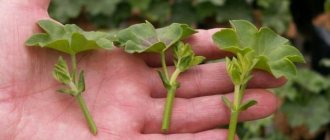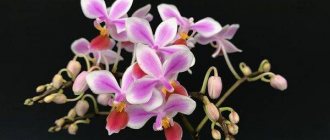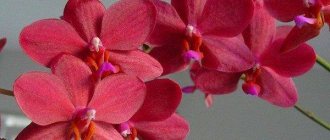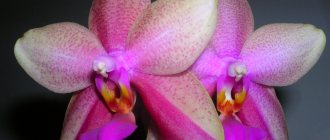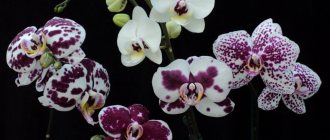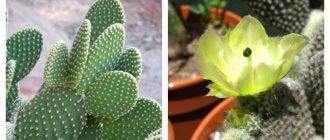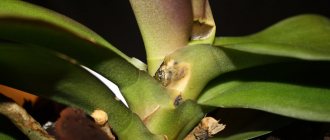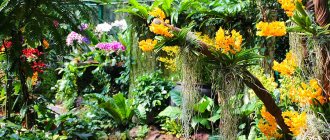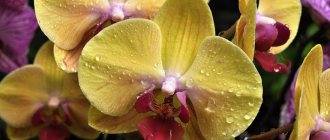Most phalaenopsis with yellow flowers are large in size; the trunk itself, the peduncle, and the flowers will differ. But there are also smaller varieties.
The flowering period usually begins in spring and lasts a couple of months; the lifespan of the trunk itself is about 7 years.
Advice! Do not cut off the peduncle of yellow phalaenopsis immediately after flowering; it may throw out buds again and repeat flowering for 6-8 months in a row.
Characteristic
Phalaenopsis yellow is a long-blooming flower with a pleasant smell, honey-colored yellow. Its broad leaves do not require much sunlight.
Like other types of orchids, Phalaenopsis is a small plant with a long peduncle reaching up to half a meter in length.
The name of this plant was given by botanist Karl Blume, who noticed the similarity of the flower with butterflies (Phalaenopsis means butterfly, moth). Phalaenopsis is native to the tropics of Southeast Asia . The main feature of this orchid is that it blooms at any time of the year. Flowering occurs several times a year and lasts up to two months. During this time, about 60 flowers appear on the peduncle.
Varieties and their photos
Phalaenopsis has up to 60 varieties, they mainly differ in shades of color and plant size. The following types of yellow orchids are most often grown at home.
Big Lip
These flowers are distinguished by their very large flowers. The height of the peduncle reaches 80 cm. The leaves are dense, bright green, covered with a thin layer of waxy coating.
Big Lip blooms twice a year, and each plant can have two peduncles. From 4 to 6 large flowers appear on each peduncle.
Multiflora
The Multiflora orchid has a very bright color ; small specks of red or crimson are noticeable on the petals. The leaves are leathery, dense, dark green.
The height of the peduncle reaches 60 cm, 7-9 large flowers appear on it, up to 6 cm in diameter.
Stuartiana
In addition to bright, unusual flowers, a feature of this type of orchid is its variegated leaves. Medium-sized flowers, painted bright yellow with red dots and a variegated center, open along the entire length of the peduncle in quantities of up to 60 pieces. The resulting waterfall of flowers pleases the eye with its blooming for a long time - up to 5 months.
Mini
The mini orchid is small in size, the height of the peduncle does not reach more than 20 cm . It blooms for a very long time, producing arrows in turn with pale yellow flowers and a bright center.
Peloric
Usually flowers of this species have several shades. Yellow color is complemented by pink, red and purple tones. It requires moisture and sunlight more than other species. The peduncle usually reaches 70 cm in height.
Phalaenopsis Pelorik blooms no more than 2 times a year and has a long dormant period.
Stewart
It is distinguished by a very pale, barely noticeable yellow tint of the petals. The peduncle grows up to 70 cm, and about 100 flowers open on it, with a diameter of 5-6 cm.
We invite you to familiarize yourself with varieties of phalaenopsis of other colors - white and cherry Wildcat, pink Liodoro and purple Schiller's orchid.
Description
Let's take a closer look at what yellow orchids look like: varieties and photos. Yellow colors are inherent in many hybrids and varieties of orchids:
- Phalaenopsis;
- Cattleyas;
- Cymbidiums;
- Dendrobiums;
- And other representatives of this family.
Yellow colors are present in many species and genera of orchids.
All of them are perennial herbaceous plants adapted to grow on tree trunks and branches. open root system helps them stay on the surface .
The top of the root is covered with a spongy shell - velamen, thanks to which moisture is absorbed from rain and fog. On hot and dry days, it serves as a reservoir that protects the plant from drying out.
The leaves of different types of orchids differ :
- Shape;
- Surface texture;
- And color.
Yellow flowers are located on the peduncle, forming an inflorescence raceme. Depending on the species, the peduncle can bear from 3-4 to 40 flowers.
The life cycle of these plants is subject to the climatic conditions in which they grow: the changing monsoon rainy season and the relatively dry winter period. Therefore, in an apartment, the plant must also go through a dormant stage, which is necessary for further growth and flowering.
Features of care
Phalaenopsis yellow is considered not a picky plant. It quickly adapts to changing environments; the temperature, light and humidity of city apartments suit it.
For Phalaenopsis you should purchase:
- transparent pot;
- special substrate;
- special fertilizer for orchids.
Suitable soil for growing orchids consists of pine bark, sphagnum peat and charcoal. After flowering, the peduncle will begin to dry out, but there is no need to cut it off immediately. Drying slowly, it releases the remaining nutrients to the plant.
If the peduncle remains green and produces new buds, it does not need to be cut . Soon the plant will bloom again. The peduncle is cut at a distance of 1 cm above the dormant bud, around which wet moss is applied. This will stimulate the appearance of a new outlet.
We invite you to watch a video about the secrets of growing Phalaenopsis orchids:
Types of orchids
Let's consider 3 types of orchids:
- Cattleya - it can be conditionally divided into an autumn/spring flowering plant, since it has a pronounced dormant period, during which its feeding and watering is strictly prohibited. It is recommended to apply fertilizer only when a fresh pseudobulb appears, and at this moment you need to fill it to a minimum, until a new peduncle with buds appears. Only after the yellow orchid has bloomed can you begin to water the plants again. In the place where the plant is located, bright light should prevail, but without direct sunlight. During the rest period, it is necessary to provide coolness.
- The yellow Cymbidium orchid is a large bush with beautiful flowers, which are often sold for cutting. Maintaining it at home is quite problematic because it requires providing 12 hours of lighting per day, avoiding direct sunlight. In winter, it feels great near a south window, and in summer it needs to be placed on a balcony, in a home greenhouse or garden. A dark leaf is an indicator of poor lighting. For winter you will need a low temperature of 10–15°C. In order for the yellow orchid to bloom, it is necessary to ensure a difference in day and night temperatures from May. If everything is done correctly, then in the very first months it will delight you with beautiful flowers. The soil differs from the standard one; sphagnum, perlite, leaf humus, sand and charcoal are added to the bark. After the flowering period, fertilizer is prohibited until spring, and so it is applied with every 3rd watering.
- Oncidium is very demanding on lighting and temperature changes. Loves a wide and low pot of opaque color, fine bark and is afraid of transplants. During the planting period, pseudobulbs cannot be deepened. The dark green speckled leaf of a yellow orchid indicates poor lighting. The permissible temperature range varies from 14 to 26°C. A daily difference of a few fractions will be beneficial. The ideal air humidity is 40%. Increased watering is required to begin with the development of young shoots; before planting, you need to dry the soil a little. Following the appearance of a new pseudobulb, flooding of the plant stops until the peduncle emerges.
Watering recommendations
It is enough to water the flower 2 times a week, and it is better to pour the water into a tray. It is necessary to observe the color of the root system, which normally should be green.
Silver color of the roots is a sign of insufficient watering. The brown color of the roots means excess moisture, which can lead to rotting of the horses. During flowering, the peduncle along with the flowers should be sprayed with warm, clean, settled water.
We invite you to watch a video on how to properly water a phalaenopsis orchid:
Reproduction
Phalaenopsis The main condition for propagation is that the flower must be absolutely healthy, with a well-developed root system and a basal rosette of 5-8 dense, fleshy leaves. Phalaenopsis can be propagated in several ways:
Reproduction of Phalnopsis by children .
In all varieties of Phalaenopsis, with proper care, not flowers periodically appear on the peduncles, but so-called babies with their aerial roots 3-5 cm long. They can be planted in a separate pot.- first they must be carefully separated from the mother plant;
dry;
- treat the cuts with charcoal;
- after that, place it in a pot with orchid substrate and wait for the growth of a new plant.
- Reproduction by dividing the bush.
Over time, an adult orchid develops several basal rosettes.In early spring, preferably during transplantation, the plant can be divided into several copies. Each will have its own root system and its own leaves.
- using a clean knife, carefully divide the plant, and sprinkle the cut areas with charcoal;
It is better to leave the plant overnight to dry;
- then plant in a pot with soil based on pine bark and charcoal.
- Peduncle cuttings.
This is the most popular method of reproduction.- after the plant has flowered, cut off the peduncle with a disinfected knife and divide it into several parts at least 3-4 cm in length and always with a dormant bud;
the cut areas are sprinkled with coal;
- It is better to plant cuttings in sphagnum moss using a mini-greenhouse or a container with a lid;
- The cuttings are placed in a warm, bright place and soon they begin to grow.
Even if you do not plan to propagate the plant, the children need to be separated; otherwise, over time, too many children can harm the plant, it will weaken and wither.
We invite you to watch a video about the methods and techniques of propagation of phalaenopsis.
1 way:
Method 2:
Transfer
After acquiring a beautiful flower, it needs to be transplanted into a plastic pot. A transparent container allows you to observe the condition of the roots and carry out timely watering.
If the yellow orchid was purchased in the spring, then it also needs to be replanted. At this time, she begins to grow rapidly, and she takes root better.
Before removing the plant from the pot, it should be pre-soaked. Then carefully detach the roots from the walls so as not to damage them, otherwise they may rot. The roots are washed and dried ones are removed.
The prepared substrate must have good permeability. It doesn't need to be compacted. To create drainage, charcoal is placed at the bottom of the pot. Crushed tree bark and moss are added to the substrate. Natural fertilizers will “feed” the orchid for a long time.
You should not replant the plant during flowering, as this will delay the next period of bud appearance.
When the contents in the pot turn into dust, the flower should be replanted. Transplantation is carried out every 3 years.
Diseases
To prevent diseases and pests, it is necessary to inspect the plant a couple of times a month. Phalaenopsis may suffer from the following diseases:
Fusarium .
A very dangerous incurable fungal disease. Appears when unsuitable soil is used, the plant is over-watered, or there is a lack of oxygen and sunlight. It is manifested by the appearance of white spots with a coating at the root rosette. If a plant becomes infected with fusarium, it will have to be destroyed along with the pot, otherwise other flowers may become infected.- Root rot.
Occurs in a humid, warm environment due to excessive watering. The leaves turn a creamy yellow color and the rest of the plant turns brown.If the disease is detected early, the plant can be saved by cutting out the affected areas and treating the wounds with a fungicide. To avoid relapse, place the plant in a cool, dry place for a couple of days.
- Bacterial disease .
Manifested by the appearance of brown spots on the leaves. As soon as you find such a stain, you need to immediately cut it out and treat the remaining damaged sheet with crushed charcoal. Otherwise, the bacteria will spread throughout the plant and it will die. - Viral infections such as Cymbidium mosaic and Odontoglossum virus .
The appearance of stripes or spots on the petals and leaves appears. They first become discolored and then become deformed. The disease cannot be treated and is contagious to other plants, so the flower along with the pot will have to be thrown away.
Pests
Most often, Phalaenopsis are attacked by pests such as thrips, spider mites, scale insects and aphids. They suck the juice from the plant, disrupting the photosynthesis of the flower. The stems wither and the buds and leaves begin to fall off.
At the first sign of parasites, you need to wash the plant well under a warm shower to wash away most of the pests. Then you need to treat Phalaenopsis with insecticides. It may take several treatments to completely get rid of parasites .
Phalaenopsis is an excellent choice of indoor plant for both experienced and novice gardeners. This hybrid with amber-yellow flowers stands out for its extraordinary beauty. It belongs to hybrids that have taken over their attractiveness from orchids, but is not a capricious plant to care for and enjoys frequent flowering.
Feeding with fertilizers
Fertilizers must be applied during the period of most intensive growth. Use special complex preparations that are created for orchids. If they are not available, then you can use any other fertilizer for flowering indoor plants. But the concentration should be reduced by 2 or 3 times. Do not water very young plants or those that have recently been transplanted with fertilizer. Keep in mind that nitrogen promotes green growth, while potassium and phosphorus help with flower bud formation and flowering.


